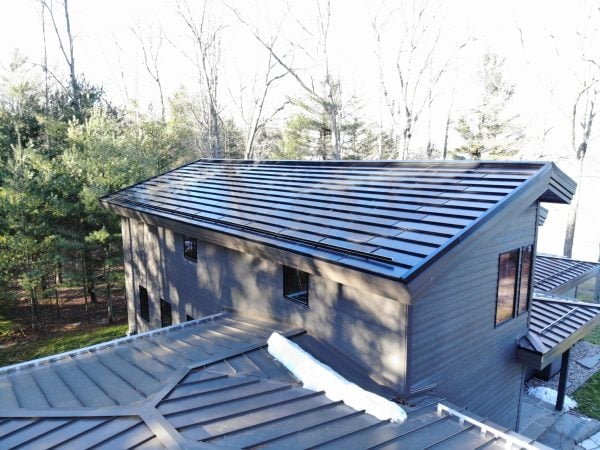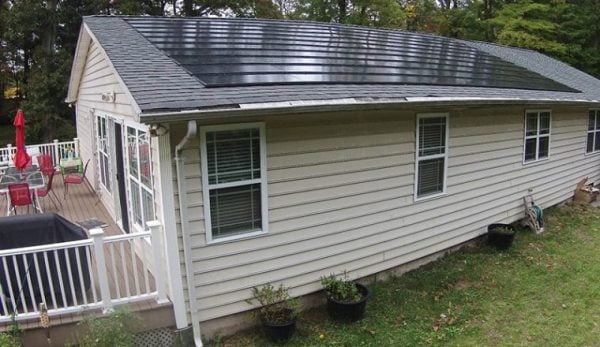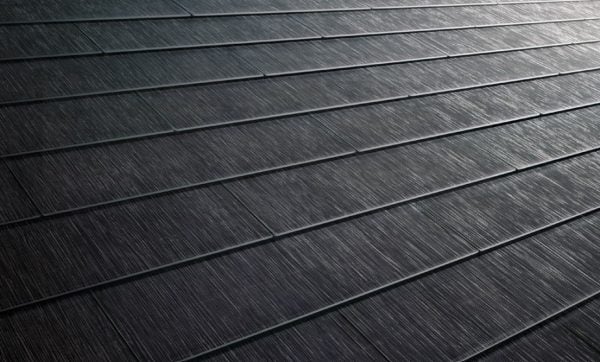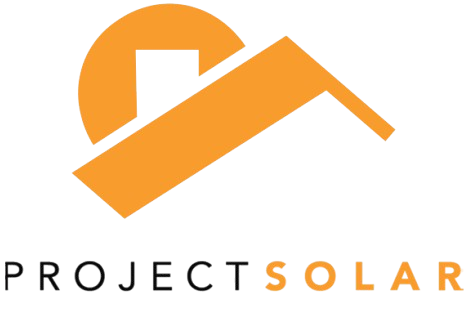Solar Shingles: Pros, Cons, How to Choose
Solar shingles are an aesthetically pleasing and durable alternative to solar panels.

Some or all of the mortgage lenders featured on our site are advertising partners of NerdWallet, but this does not influence our evaluations, lender star ratings or the order in which lenders are listed on the page. Our opinions are our own. Here is a list of our partners.
What are solar shingles?
Solar shingles are roof shingles made of photovoltaic (PV) cells, the same electricity-generating material on solar panels . There are two main types of solar shingles: CIGS (copper-indium-gallium-selenide), which use thin-film technology to generate electricity, and silicon, which resemble traditional solar panels proportioned to fit with conventional roofing materials.
How much do solar shingles cost?
Solar shingles typically cost about $35,000 to $75,000 for a full roof, making them a more expensive option than solar panels. However, for many people they are a durable and more attractive alternative to solar panels.
Solar shingle pros and cons
| Pros | Cons |
|---|---|
| Does double duty as a roof and solar system. | Typically not as efficient as traditional solar panels. |
| Pleasant aesthetics. | Higher upfront cost than solar panels. |
| Limited style options. | |
| May not be a good fit for all roof types or conditions. | |
| Requires specialized installation expertise. | |
| Easier to maintain than solar panels. | Relatively new technology; not as time-tested as solar panels. |
| Can be cost-effective if you are building a new roof. | Can’t be moved or repositioned to capture more sun or increase efficiency. |
» MORE: Are solar panels worth it?
Are solar shingles worth it?
Here are some factors all prospective buyers can consider when shopping for solar shingles:
- Appearance. Look for shingles that go well with your home. You can find solar shingles in styles that range from modern to traditional, so there should be something out there that suits your house.
- Budget. You’ll need to find a solution that you can afford. When considering the financial impact of this decision, research possible tax incentives that could offset your upfront costs, and factor in projected energy savings over the coming years.
- Suitability of your roof. Evaluate your roof’s orientation, size, shape and amount of sun it receives to make sure you’d generate enough electric power from solar shingles to make your investment worthwhile.
- Energy requirements. Calculate your home’s energy usage to make sure you select a solar shingle system that’s sufficient to meet or offset your energy consumption without being too powerful for your needs.
- Efficiency ratings. Look for the most energy-efficient shingles within your budget to get the best return on your investment.
- Provider. Choose a reputable manufacturer, known for a high-quality, durable product that comes with solid warranty protection.
» MORE: How to compare solar quotes
Solar shingles vs. solar panels
Although solar panels are mounted on your roof (or on the ground on your property), solar shingles function as your roof, providing shelter from the elements and producing solar electricity. Here’s how these two technologies stack up.
Price
Winner: Solar panels
Solar panels use relatively older technology and are typically less expensive to purchase upfront than solar shingles. If your roof is in good condition, solar panels might be a more cost-effective option. However, if you’re planning to replace your roof anyway, solar shingles might make more sense.
Appearance
Winner: Solar shingles
Solar shingles are designed to look like standard roofing materials; solar panels are engineered to capture maximum sunlight. Your choice depends on how you balance efficiency and curb appeal.
Flexibility
Winner: Solar panels
If you’ve got a flat roof, solar panels may be a better option. Solar panels are compatible with all roof types — and they can also be installed on the ground.
Efficiency
Winner: Solar panels
Solar shingles typically aren’t as efficient as solar panels because there’s no air flow under them. Because of this, they get hotter and produce energy at a lower rate. Unlike solar panels, which can be positioned to catch the most sunlight, solar shingles are fixed and have to be positioned as your regular roof shingles would. Depending on the orientation of your roof, this may also result in less than maximum potential efficiency.
Lifespan/durability
Winner: Tie
Both technologies are designed to last for about 20 to 30 years on average .
Types of solar shingles
There are two main types of solar shingles:
- CIGS (copper-indium-gallium-selenide) solar shingles. These shingles use more recently developed thin-film technology to generate home solar power. They can also be made into more flexible and lighter shingles to blend into existing or new roofs.
- Silicon solar shingles. These rigid solar shingles are more like traditional solar panels and are sized to fit with conventional roofing materials.
Solar shingle providers
Here are three examples of solar shingles providers and what their shingles look like.
Luma Solar
Luma Solar says it's the first company to develop rooftop solar shingles in North America. Designed for hurricane-force winds, these shingles can withstand winds of 200 mph and higher. The company offers a power warranty of 25 years and a limited lifetime shingle warranty.

SunTegra
SunTegra’s solar shingles are rated for weather conditions, including snow, wind and fire. The company also offers a limited product warranty of 10 years and a 25-year limited power warranty.

Tesla Solar Roof
Tesla’s fully integrated solar roof shingles are designed to withstand fire, high winds and hail. They come with a power and tile warranty for 25 years.

Can I get financing for a solar panel system?
In addition to tax incentives and rebates, there are options available. Many solar installers offer financing, but you may also be able to finance your solar investment through a home equity loan or home equity line of credit (HELOC). These options may have lower interest rates than financing with an installer, future opportunities for refinancing and possible tax benefits.
Home equity loans and HELOCs are ways to borrow against the value of your home, converting equity into cash. With a home equity loan, you receive a lump-sum payment and then pay it back at a fixed interest rate over an agreed period of time, typically from five to 30 years. HELOCs are more akin to a credit card, something you use as needed. You’ll usually have 10 years to draw from the line of credit, during which time you only have to pay interest, and after that you pay both the principal and interest. HELOC interest rates typically are variable, meaning your monthly payment could rise or fall over time. And with each of these options, you're using your home as collateral.
Advertisement
Min. credit score 600 | Min. credit score 600 |
Min. down payment N/A | Min. down payment N/A |
Another option is a solar loan. Many banks, credit unions and online lenders offer these to fund solar panels and installation, with amounts typically from $1,000 to $100,000, and annual percentage rates ranging from 6% to 36%. They function like a personal loan: you receive a lump sum and repay it in equal monthly installments over a set period, typically two to seven years. And unlike with home equity financing, there is no collateral required for a solar loan. This means your home or solar panels aren’t at risk if you miss payments, but you may have to pay late fees.
So, yes, you likely can get financing. If you go this route, compare interest rates, terms and fees with any financing package that a solar provider may offer you to ensure you get the best deal.
Frequently Asked Questions
Is solar shingle installation a good DIY project?
No. Solar shingles should be installed by an experienced, certified professional.
How much might a Federal solar tax credit offset the cost of solar shingles?
If your shingles are eligible, the tax credit can be as much as 30% for installations done between 2022 and 2032.
What do I need to do to maintain my solar shingles?
Not much. The rain will wash away most accumulated dirt and debris, and you can gently rinse away anything remaining with a regular garden hose when the shingles are cool.
Article sources
NerdWallet writers are subject matter authorities who use primary,
trustworthy sources to inform their work, including peer-reviewed
studies, government websites, academic research and interviews with
industry experts. All content is fact-checked for accuracy, timeliness
and relevance. You can learn more about NerdWallet's high
standards for journalism by reading our
editorial guidelines.
- 1. Photovoltaics Program; Office of Solar Energy Technologies. Solar Roofing Shingles: Integrating photovoltaics into roofing shingles produces clean solar power. Accessed Mar 22, 2024.
- 2. Energy.gov: Office of Energy Efficiency and Renewable Energy. Replacing Your Roof? It’s a Great Time to Add Solar. Accessed Mar 19, 2024.
More like this
Related articles
AD
Save On Solar Without the Middleman
Free Instant Quote
on Project Solar's website

AD

Save On Solar Without the Middleman
- $750 OFF install with NerdWallet;
- SolarCare™: top-tier warranty & 25-year production guarantee;
- No sales commissions mean premium equipment & tech at up to half the price.

Free Instant Quote
on Project Solar's website











